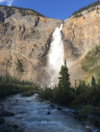Rivers and Waterfalls Flashcards
Describe what the source of the river is?

The source is the beginning of a stream or river. (Could be from a lake, a marsh, a spring, or melting glacier)
In the first picture, the source of the river is a melting glacier. (Look above the finger which is pointing to the falls, not the glacier.)
In the second picture, the source is a marsh.

What are the banks of a river?

Banks are the sides of a river or stream between which the water normally flows.
Both pictures show the different types of river banks. One is more rugged than the other.

What is a river bed?

The bed is the bottom of the river.
On the first picture I am walking on a very stoney river bed. The water was freezing because it is a glacier-fed river. The second picture shows a dry river bed (drought in the west this summer).

Describe erosion done by a river.

The flow of the water wears away the bed and banks of a river.
The first picture actually shows a chunk of the bank breaking off. The second picture shows how the water eroded solid rock.

What is sediment in a river?

Sediment is small particles of soil or rocks that are transported by water. They are usually caused by erosion.
Note the “muddy” water in the pictures.

What are tributaries?

Rivers or streams that flow into a larger river or stream. (Like the branches of a tree joining into the main trunk.)
Both images show the “branching” of smaller rivers or streams joining a larger river.

Describe a watershed.

The land that drains water into a particular stream, river, or lake.
The first picture shows that the Great Lakes and surrounding land all drain into the St. Lawrence River. The second picture shows the ocean watersheds. Can you figure out what ocean the St. Lawrence River goes into?

What is a flood plain?

The wide, flat floor of a river valley. It consists of sediments deposited by the river. It can be covered by water during a flood.
You don’t want to build a house in a flood plain!

Describe where to find a V-shaped river valley.

A deep v-shaped valley is usually found in the upper section of the river where the water is flowing quickly.
You have already seen the second picture. It clearly shows how the V-shape of the valley is caused by the power of the water as it melts from the glacier.

What is a gorge?

It is a a steep-sided, narrow, rocky valley marking the retreat of a waterfall.
The Niagara Gorge is the first picture. The Grand Canyon was also formed by the power of a river. It took over a million years of erosion by the Colorado River to make the U-shaped canyon.

Describe what a meandering river looks like.

It follows a winding path. The water is usually moving slowly.
What are rapids?

They are caused by the river going over hard rocks in the river bed.
We are going to see the rapids when we do the White Water Walk at Niagara Falls.

What is a river mouth?

The mouth is the end of a river where it empties into a large body of water.
What is a delta?
(The bright green shows new land that was formed by sediments dropped by the great Mississippi River.)

A delta is a large, silty (tiny particles of soil) area at the end of the river where it meets a lake or the ocean. New land can be created at deltas.
We canoed across the lake to the river mouth. Note the small islands that were forming. All of the sediments were eroded by glacier melt water.

What creates a waterfall?

Waterfalls form where there is a sudden drop in a river as it flows over a rock cliff. The river erodes softer rock after flowing over an area of harder rock.

What are whirlpools?

A powerful circular current of water.
The second picture shows the Whirlpool at Niagara Falls that we will see!

How are Pot Holes created?

Holes eroded in the solid rock of a river channel. Thy are drilled by pebbles caught in the eddies or whirlpools in the river.

What does a Cascade Waterfall look like?

A waterfall that goes over a series of rock steps.
What does a Ribbon Waterfall look like?

It is a narrow waterfall that is higher than it is wide.
What is a Block or Sheet Waterfall?

It is wider at the top than it is high.
The first picture is Wapta Falls in BC. You had better know the second falls!

What does a Punchbowl Waterfall look like?

They have wide pools at the bottom of the falls.


